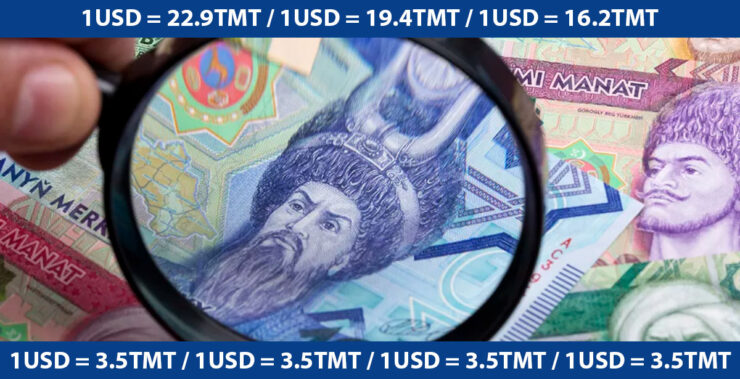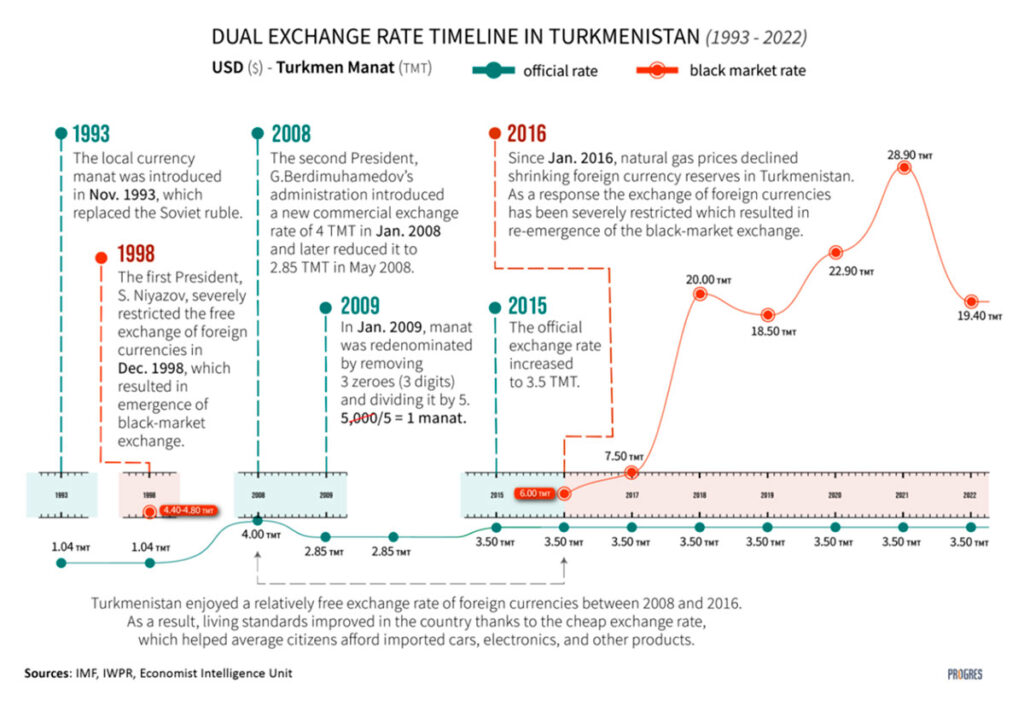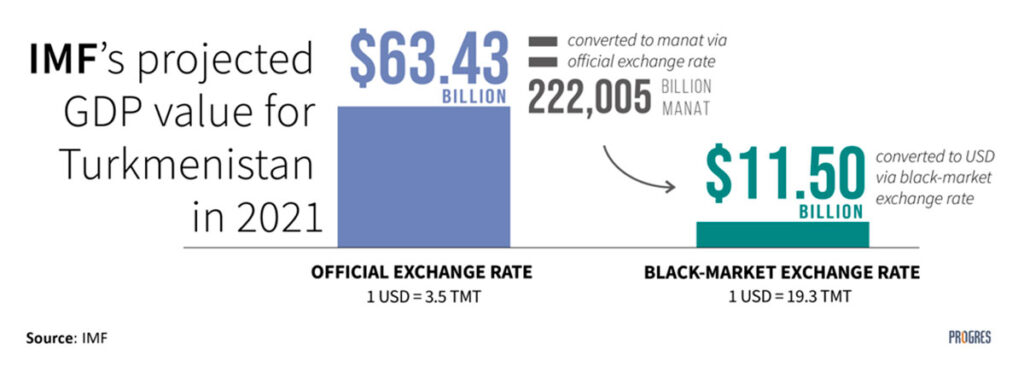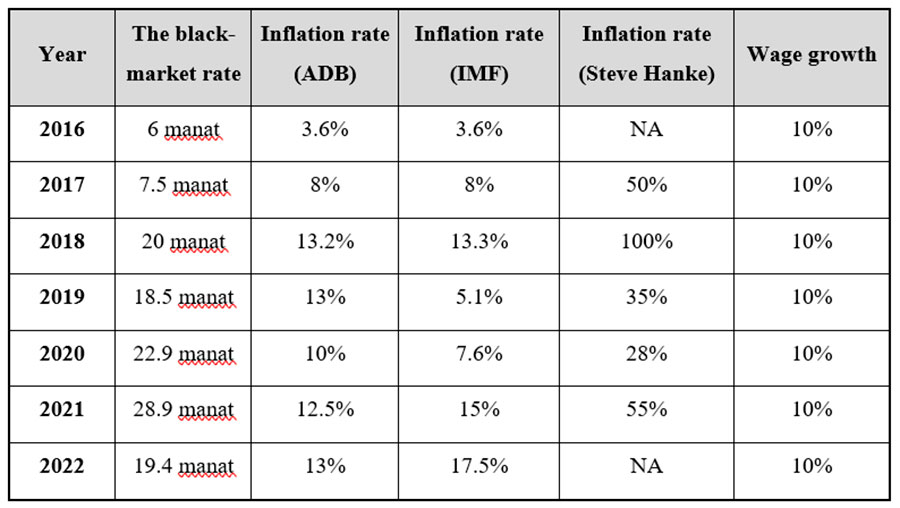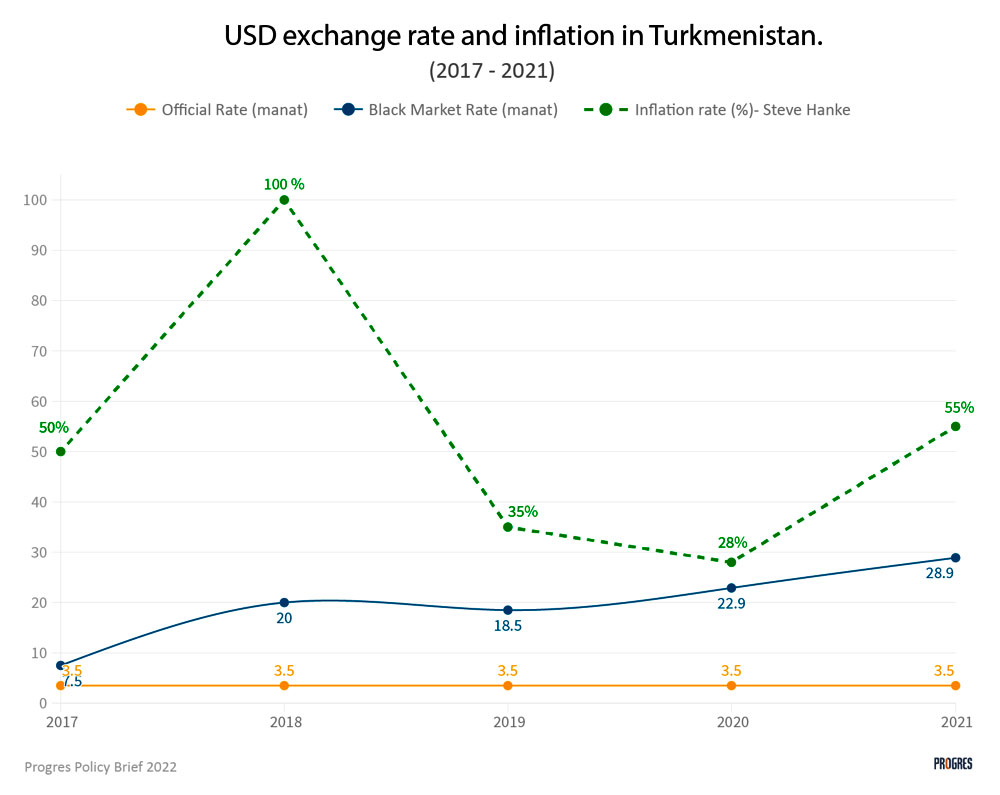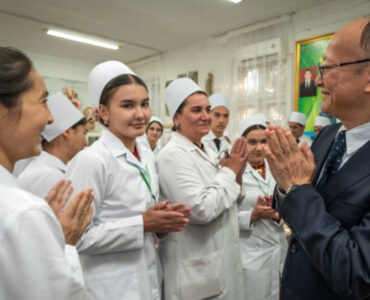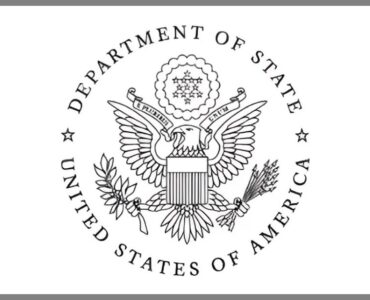Purpose
The goal of this policy brief is to inform the public in Turkmenistan and address the impacts of the dual exchange rates on Turkmenistan’s economy. The government restricted the free exchange of foreign currencies in 2016 and as a result, the dual exchange rate was established: the official exchange rate and the black-market exchange rate. The dual exchange rate regime has had deleterious effects on the welfare of the general population and negatively impacted the business climate and the foreign direct investment (FDI) inflows. Progres.online provides an overview of the problems and recommendations based on data from open sources.
Background
Turkmenistan has been experiencing an economic crisis (the Foreign Policy Center, Steve Hanke, the Economist) since 2016 characterized by high inflation and a food crisis along with the emergence of the black-market exchange rate regime. In 2016, the government in Turkmenistan restricted the exchange of foreign currencies, which paved the way for the creation of the black-market exchange rate in Turkmenistan. The official exchange rate has remained the same at a fixed rate of 3.5 Turkmen manat to 1 USD since 2015. The black-market rate has had drastic swings in the last couple of years reaching as high as 37.8 manat in April 2021 (10 times more expensive). While the official exchange rate is fixed by financial authorities, the black-market rate value reflects the market dynamics of supply and demand.
Turkmenistan never had private currency exchange offices. Currency exchange could be done only through the banks, all of which are controlled by the state. The Central Bank of Turkmenistan does not admit the existence of the black-market exchange rate and it does not report any changes in the value of the dual rate. The State Committee on Statistics of Turkmenistan and the Ministry of Finance and Economics do not publish economic data and inflation trends in the country. Due to the lack of macroeconomic indicators, it is difficult to meaningfully interpret and analyze the economic trends in Turkmenistan.
International financial institutions on Turkmenistan’s dual exchange rate regime
Several international financial institutions touched upon the topic of currency conversion problems in Turkmenistan. For instance, EBRD states that currency convertibility issues should be resolved, and the exchange rate adjusted to reflect macroeconomic fundamentals. IMF staff during their visits to Turkmenistan in 2017, 2018, and 2019, have repeatedly recommended the government adjust the exchange rate level while easing foreign exchange regulations. IMF noted that significant overvaluation and foreign currency rationing are among the factors that weigh on private investment and competitiveness of non-hydrocarbon exports.
The US Department of State’s “Investment Climate Statement” report on Turkmenistan states that strict foreign currency controls have resulted in a black-market exchange rate for dollars and highlights its consequence as the inability of firms to convert local currency to dollars to import supplies or equipment. Based on the experiences of other countries, World Bank economists highlight that dual exchange rates provoke distortions by manipulating relative prices in the economy and opening opportunities for rent-seeking behavior for those who have access to preferential rates. Eliminating dual exchange rates thereby would lead to a more efficient application of market-driven relative prices to allocate resources in the economy.
The history of currency exchange in Turkmenistan
The local currency manat was introduced in November 1993, which replaced the Soviet currency ruble. The country has faced dual exchange rates between 1998-2008 and from 2016 to the present day. During the first dual rate (1998-2008) the difference between the official and the black market exchange rate was more than 4-fold (1.04 manat vs 4.4-4.8 manat) and during the second dual rate (2016-present), the black-market premium became 557% as of publishing (3.5 manat vs 19.5 manat). See Figure 1 for more details.
How and why did dual exchange rates happen?
Turkmenistan has not fully industrialized its economy over its 31 years of independent history. Its main revenue is generated through the exports of natural gas, mainly to China. Total merchandise exports of Turkmenistan in 2021 were 9.2 billion USD, of which 93.2% belong to the exports of natural gas and oil (8.6 billion USD).
Such a huge dependence on commodity exports makes the country vulnerable to external shocks. Gas prices in international markets dropped in 2014 and later the country stopped selling gas to Russia and Iran in 2016 and 2017. Reduction in gas prices drastically deteriorated the country’s trade balance and reduced the net inflow of foreign currencies. It resulted in various restrictions on currency exchanges in 2015 by setting a limit to convert only $500 per person per month for currency exchanges of non-commercial nature (Eurasianet). Moreover, in the same year, authorities permitted the sale of properties only in physical national currency.
Due to such pressures, The Economist Intelligence Unit (EUI) expected the manat to devalue by 30% in early 2016. However, instead of devaluing the fixed exchange rate, the authorities practically banned the sale of foreign currencies in the country from January 2016 (EIU). This immediately created demand for a parallel black market, which sold/bought foreign currencies at higher rates than the official exchange rate set by the government of Turkmenistan. As a result, the dual exchange rate was established: the official exchange rate and the black-market exchange rate.
Based on Turkmenistan’s Administrative Offenses Code, selling and purchasing foreign currency via informal channels as well as trading in foreign currency on the territory of Turkmenistan were made illegal (state.gov). There is no publicly available data on the quantity of foreign currency reserves in Turkmenistan. Moreover, the Central Bank of the country does not hold independent power over monetary policy.
Converting money via the official exchange rate can be accessed only in the following cases:
- Turkmen nationals: people can convert dollars and euros to their bank accounts in the amount of $50 per month per person provided that they only withdraw dollars and euros abroad, using their Visa and Mastercard cards.
- Students studying abroad: Currently, students can only exchange their manats to USD at the official exchange rate for a maximum amount of $12,000 per year to cover tuition fees and monthly living costs (to students’ Visa and Mastercards). The limit to exchange currencies for monthly living costs was first set at 1000$ per month in 2016, then it was gradually reduced to $50 per month in 2021.
- Medical treatment: Turkmen nationals are able to convert manat into USD if they need a medical treatment that is not available in Turkmenistan for a maximum of $20,000 per year. The basis for obtaining the right to convert money for treatment abroad is the written conclusion by the Ministry of Health confirming that the medical condition is not treated in Turkmenistan.
- Domestic production: business owners wishing to buy inputs, raw materials, and equipment from abroad for domestic production can have access to the official exchange rate. However, the amount of the converted money should not exceed 2% of the total amount of the contract per month.
How does the dual exchange rates affect GDP calculations?
The existence of the black-market exchange rate makes it really difficult to interpret the GDP figures of the country. The GDP of Turkmenistan is calculated in the national currency manat and converted into dollars via the official exchange rate. IMF’s projected nominal GDP value for Turkmenistan in 2021 was 63.43 billion USD which accounts for 222,005 billion manat based on the official exchange rate (1USD=3.5 manat). However, based on the black-market exchange rate (1USD=19.3 manat), the GDP becomes 11.5 billion USD.
The same is true for GDP per capita, which is 10,310 USD via the official exchange rate and 1,870 USD per black-market exchange rate. Among the neighbors, GDP per capita is 10,041 USD in Kazakhstan, 1,983 USD in Uzbekistan, 1,276 USD in Kyrgyzstan, 897 USD in Tajikistan in 2021 (World Bank). Due to such a big difference between the official and black-market rates, the GDP numbers distort the statistics and make it difficult to understand the country’s economic welfare. Based on the official rate, the country seems to be wealthier and better performing than other neighboring countries. Therefore, planning an economic policy based on misleading indicators can result in inefficient policies.
Who are the beneficiaries of the dual exchange rates?
Those who live in Turkmenistan and earn their income in USD or other foreign currencies are the obvious beneficiaries of the black-market exchange rate. Mostly, those who work for foreign embassies, international organizations (the World Bank, UN, EBRD, etc.) and international companies (Dragon Oil, Schlumberger, etc.) earn in foreign currencies. They can benefit from exchanging their salaries received in USD to manats through black-market rates. Other possible beneficiaries of the parallel rate are the minority of business owners who have access to the cheap exchange rate.
How do the dual exchange rates affect the different categories of actors?
We divided into three broad categories of actors, who experienced negative impacts from the existence of the black-market exchange rate. These are: the general population; businesses and foreign direct investments.
Donate to support Turkmen analysts, researchers and writers to produce factual, constructive and progressive content in their efforts to educate the public of Turkmenistan.
SUPPORT OUR WORKGeneral population: The existence of a dual exchange rate negatively affects consumers, especially families in low-income groups. As of this writing, the black-market exchange rate is almost 5.5 times higher (3.5 manat vs 19.3 manat) and there is a growing correlation between the parallel rate and inflation in the country. Authorities do not publicly share the rate of inflation, but we can learn the dynamics of inflation via IMF, ADB, Prof. Steve Hanke, and Palaw Index (food inflation).
Source: ADB; IMF; Steve Hanke’s Inflation Satellite
As you can see from the table, there is a large difference in inflation numbers of IMF and ADB with Prof. Steve Hanke’s data as the latter measures inflation by tracking the changes in the black-market exchange rates and using purchasing power parity. Several international reports also claim that Turkmenistan has been experiencing a food crisis and high inflation since 2016-2017 (Aljazeera; Eurasianet; Human Rights Watch).
Palaw Index is another tool through which food inflation in Turkmenistan is measured by tracking the prices of palaw ingredients, a Turkmen dish. However, the Index started collecting prices in 2020 and there is no data covering the inflation rates for 2016-2020 years. Recent numbers of the Palaw Index in 2022 show a direct correlation between the value of the black-market exchange rate and the cost of palaw. Changes in food prices have an impact on the welfare of the average people as 52.1% (UN Turkmenistan, 2020) of total household expenditures in Turkmenistan constitute expenses on food.
Business
The existence of a dual exchange rate also hinders business development and negatively affects production and the economy in general. Domestic producers wishing to buy machinery, equipment, and inputs from abroad can only convert 2% of the total amount of contracts per month. Entrepreneurs engaged in food production were given priority in currency conversion, followed by those engaged in the production of industrial goods. There were no entitlements for the conversion of funds of importers engaged in the import of finished products and the responsibility was transferred to the discretion of the authorized banks themselves in the presence of their own foreign exchange funds (Turkmennews).
Despite the priorities of certain sectors, the process of conversion involves a rigid bureaucracy and many businesses had to wait for months to get approval and convert their money. This created incentives for corruption and nepotism. According to Transparency International’s “Corruption Perception Index” in 2021, Turkmenistan ranked as the 11th most corrupt country in the world by ranking at 169th place out of a total of 180 counties. As a result of conversion restrictions, the prices of finished imported products have gone up considerably, as well as the prices of pharmaceuticals, which are necessary for medical treatments. Domestically produced products are also negatively impacted by currency restrictions. Local producers import technical equipment, raw materials, and other production inputs from abroad. That also raises the price of domestically produced goods.
Due to the restricted exchange rate regime, many people are reluctant to invest and start businesses. This translates into lower production volumes and job opportunities. What happens to businesses affects consumers as well. Due to a lower production associated with the prevalence of the black-market rates, supply goes down and prices go up. Finally, due to the direct impact of the black-market exchange rate on the prices of goods and services, producers and consumers will be deprived of price signals, which are necessary to gain knowledge about price changes of certain products (Hayek, 1945). Under normal circumstances with free exchange rates and inflation rates, prices act as a signal to producers and consumers when price changes occur. The information conveyed by prices is an essential feature of a free market economy, which helps producers to decide on what to produce, how to produce, and what resources to use in production.
Foreign direct investment (FDI)
FDI is crucial for the country’s growth, increases production, and offers jobs to the local population. Some reports claim that due to the restrictions on foreign exchange, several foreign companies in Turkmenistan had to downsize or halt their businesses due to an inability to repatriate their profits and pay off debts denominated in dollars (export.gov). The Russian Chamber of Commerce and Industry stated that trade with Turkmenistan is hindered by a double exchange rate and conversion restrictions. The amount of FDI as a percentage of GDP was 4.7% in 2019 according to the World Bank’s latest available data, however, the Investment Climate Statement prepared by the US State Department notes that Turkmen authorities “often count foreign loans as FDI, but there is little genuine FDI in the country”.
The US State Department report also claims that “Turkmenistan is currently considered high risk for U.S. foreign direct investment due to endemic corruption, a weak commercial law and regulatory regime, opaque and onerous bureaucratic processes, and strict foreign currency controls”.
What are the experiences of the neighbours?
Among the neighboring post-Soviet countries, Azerbaijan, Kazakhstan, and Uzbekistan have had the dual exchange rates before and all three unified their exchange rates between 2014 and 2017. Exchange rate unification implies the new exchange rate, which combines the previous official exchange rate and the black-market rate.
Source: IMF 2021
Tajikistan has had a black-market exchange rate since 2015 and it is still in place as of publishing.
Neighboring Uzbekistan had a black-market exchange rate from 1996 to 2017 under the first President of the country, Islam Karimov. During the dual rate regime, the official exchange rate was a fixed rate, but it was regularly changed and adjusted to reflect changes in the black-market exchange rate. The new President, Shavkat Mirziyoyev, dismantled the double exchange rate in September 2017. Before the dissolution of parallel rates, the official exchange rate was set at 4,200 soms to the USD, while the black-market rate was 7,700 soms. However, under the new unified exchange rate, it was set at 8,100 soms, which was even higher than the black-market rate. From August 2019, the unified exchange rate was allowed to be freely floating reflecting the supply and demand without daily fluctuation limits. Individuals could buy foreign currencies from banks and street exchanges freely without any restrictions. However, as the unification of the exchange rate occurred very recently, it is too early to draw conclusions.
Recommendations for transitioning to a unified exchange rate
Experts from the World Bank outline two different approaches to unifying the dual exchange rate. These are “the big bang” and “gradual” devaluations. While big bang devaluation entails a sudden and immediate switch to a new exchange rate, the gradual devaluation implies from its name a gradual transition to a unified exchange rate. Empirical results show that unification is preferred if implemented in a gradual way provided that it is done in a credibly established and defendable path. However, the unification of exchange rates can only be successful if it comes along with fiscal reforms, in which the gap between government revenue and spending is diminished.
Given the overvaluation of the current fixed exchange rate, the government of Turkmenistan should strive to devaluate the official rate to match the current economic realities. Once devaluation occurs, it is up to the Central Bank to maintain the exchange rate on a fixed or floating rate as we do not suggest one over another. Moreover, increased transparency on Central Bank’s foreign reserves will be helpful to better analyze the monetary trends. Most importantly, it is imperative that currency exchange remain freely accessible to everyone with clear guidance about the way to access them.
Due to the insufficient information on the supply and demand for national manat and foreign currencies (USD), it will be difficult for us to determine the exact value of the unified exchange rate. However, one thing we do know is that the current dual exchange regime is extremely harmful to the economy, consumers, and people in low-income groups in Turkmenistan. Since the current official rate (3.5 manat/USD) is overvalued, the unified rate can be somewhere between the official and black-market rates. Uzbekistan for instance unified its exchange rate by putting the value slightly higher than the black-market exchange rate. Nevertheless, it is crucial to draw the lessons based on the best practices to ensure a smooth transition to a unified exchange rate.
There might be worries that unifying exchange rates will increase inflation rates in the country. Once the exchange rate is unified, its value will probably be significantly higher than the current overvalued official rate of 3.5 manat and closer to the market rate of 19.5 manat. This in return can potentially raise the prices of goods and services. However, prices of most products and services in Turkmenistan already reflect the black-market exchange rates, and prices are heavily influenced by the changes in the value of the black-market rates. The Palaw Index reports show a consistent correlation between the price changes for food and black-market exchange rate increases. The reason for such a relation is that majority of business owners do not have an access to cheap exchange rates. Thus, they buy USD from the black-market exchange rate to buy imported products as well as technical equipment and raw materials.

